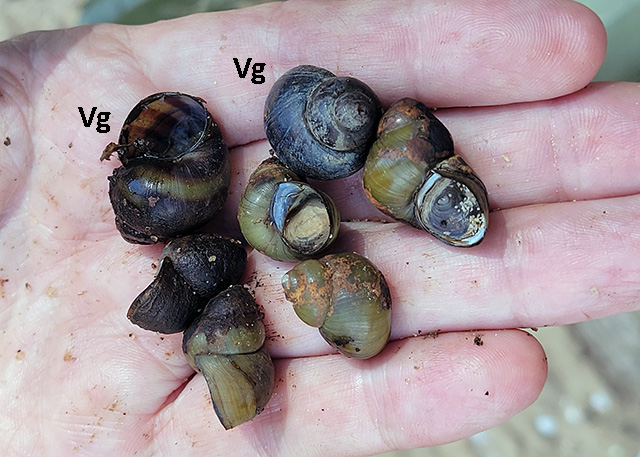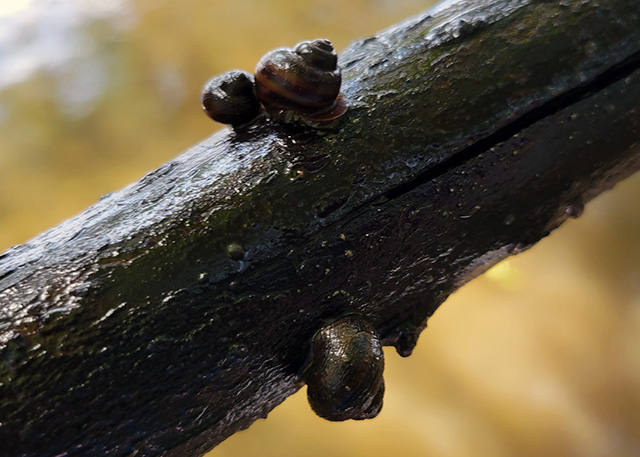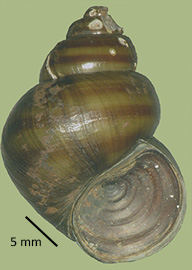Viviparus contectoides, Callinina georgiana
> Habitat & Distribution
Clench (1962) gave the natural range of V. georgianus as "north central Florida, Georgia, Alabama and north, mainly in the Mississippi River system, to Illinois and northwest Indiana," suggesting that the occurrence of populations throughout the American northeast and into Canada might represent a recent (and often human-mediated) invasion. Oddly, V. georgianus populations today seem much more widespread and dense in northern latitudes than they do in Georgia, from whence the species was described.
We are aware of two relatively recent introductions in southern Atlantic drainages a population inhabiting Buggs Island Lake at Occoneechee State Park on the VA/NC border, called to our attention in 2006, and a population introduced into the adjoining Lakes Marion and Moultrie of South Carolina, apparently dating to the mid-1990s (see my essay of 29Oct03 from the link below.) By 2015 the South Carolina population had spread north up the Catawba/Wateree River into Lake Wylie on the North Carolina line. Clench (1962) also reported a historic V. georgianus introduction in the Potomac River near Washington that we have been unable to confirm. I reviewed all the Viviparus records in the USGS Nonindigenous Aquatic Species database in my blog post of 16Oct15.
Our surveys of US interior drainages have uncovered (presumably native?) populations of V. georgianus in the lower reaches of the Wabash, Green, and main Ohio Rivers, and several (possibly introduced) populations in northern Indiana. Populations are also not uncommon in the Tennessee drainages of North Alabama. We are aware of one V. georgianus population in a tributary of the Cumberland River, the West Fork Stones. FWGNA incidence rank I-4.
> Ecology & Life History
Cook (1949) has documented filter feeding (or perhaps ciliary feeding is more descriptive) in the European V. viviparus. But standard grazing also seems to be an option. The experiments of Duch (1976) convincingly demonstrated both a preference for silt-mud substrate over rock bottom in V. georgianus, and a strong orientation toward silt containing diatoms. The Lake Marion snails were commonly observed associated with macrophytes early in the brief history of their invasion, but recently are more commonly collected burrowing in sand. The experiments of Studier & Pace (1978) suggest that substrate preference in Viviparus may be more a function of the food it contains than its texture.
Northern V. georgianus populations show a broad range of life cycle pattern, maturing in a single year and reproducing iteroparously (Browne 1978), maturing in two years and reproducing iteroparously (Buckley 1986), and maturing in three years followed by semelparous reproduction (Jokinen et al. 1982). Applying the classification system of Dillon (2000: 156 162) these would be life cycle patterns G, Hi, and T, respectively. Browne reported a 9-month gestation period (June March) in his New York populations. The mortality that may follow reproduction (perhaps natural in some populations) can yield spectacular accumulations of dead shell. The energetic data collected by Browne (1978) suggested to Dillon (2000: 126 131) that V. georgianus is Undifferentiated with regard to its life history adaptation. Jokinen s (1987) analysis of the distribution of V. georgianus in Connecticut and New York led her to classify it as an A-B tramp, typically present only in the more species-rich communities.
David and colleagues (2017) estimated a mean summer prevalence of echinostomatid trematodes in one New York population of V. georgianus at a whopping 66.7%. Minnesota populations have been implicated as the primary intermediate host for digenean trematodes causing significant waterfowl mortalities. See my essay of 14Nov07 from the link below.
> Taxonomy & Systematics
Paludina georgiana was described by Isaac Lea (1834) from Hopeton Plantation, near Darien, Georgia. Clench (1962) listed among the junior synonyms contectoides (Binney 1865), fasciata (Tryon 1870), and walkeri (Pilsbry & Johnson 1912). The allozyme study of Katoh & Foltz (1994) revealed, however, that populations referred to V. georgianus in Florida comprise as many as three cryptic species: goodrichi and limi in the panhandle and georgianus (s.s.) further east.
Clarke (1981) noted the striking similarity between invasive, Canadian populations of V. georgianus and the European Viviparus viviparus, speculating that northern Viviparus populations might represent a cryptic invasion from Europe. More recently-published DNA sequence data do not seem to bear this out (Stelbrink et al. 2020) although which Floridian species our northern invasive populations might match, if any, remains an open question (David et al. 2017). For more, see my essay of 9Mar21 from the link below.
The higher-level taxonomy of the North American Viviparidae has been relatively stable since the brief monographs of Clench (1962) and Clench & Fuller (1965). The single-character classification published by Stelbrink et al. (2020) is interesting, but (long experience suggests) too volatile to trigger any taxonomic reshuffling at this time. See my essay of 9Mar21 from the link below for more.
> Maps and Supplementary Resources
- Map of Viviparus distribution in Atlantic drainages (2023)
- Viviparus distribution in Georgia and the Florida panhandle (2025).
- Viviparus in the drainage of The Ohio (2019)
- Viviparus in the Tennessee/Cumberland (2022)
- Two V. georgianus and six V. subpurpureus. Thanks Wes Reynolds.

- Juvenile V. georgianus from Lake Marion, SC. Thanks Wes Reynolds.

> Essays
- I posted an essay on invasive viviparids in South Carolina to the FWGNA web site on 29Oct2003. There are links to several additional photos. See Invasive Viviparids in South Carolina
- In 2007 Viviparus georgianus was implicated as the primary intermediate host for digenean trematodes causing massive waterfowl mortalities in Minnesota. See Ducks, Snails, and Worms - When Invasive Species Conspire!
- My FWGNA blog post of 12Sept11, Dispatches from the Viviparid Front, included an item on a citizen's effort to monitor invasive viviparids (of all species) in Wisconsin, with links to some good references.
- I reviewed all the Viviparus records in the USGS Nonindigenous Aquatic Species database while researching my post of 16Oct15, "To Only Know Invasives." I didn't find any well-documented populations here in The East previously unknown to me.
- I reviewed A Gene Tree for the Worldwide Viviparidae published by Stelbrink et al. (2020) in my post of 9Mar21. The focus of that essay was on Cipangopaludina, but the origin of northern V. georgianus populations was also addressed.
> References
Aldridge, D.W., Russell-Hunter, W. D., & Buckley, D.E. (1986) Age-related differential catabolism in the snail, Viviparus georgianus, and its significance in the bioenergetics of sexual dimorphism. Can. J. Zool. 64: 340-346.
Browne, R. A. (1978) Growth, mortality, fecundity, biomass and productivity of four lake populations of the prosobranch snail, Viviparus georgianus. Ecology 59: 742-750.
Buckley, D.E. (1986) Bioenergetics of age-related versus size-related reproductive tactics in female Viviparus georgianus . Biol. J. Linn. Soc. 27: 293-309.
Clarke, A. (1981) The Freshwater Molluscs of Canada. National Museums of Canada. 445 pp.
Clench, W. (1962) A catalogue of the Viviparidae of North America with notes on the distribution of Viviparus georgianus, Lea. Occas. Pprs. on Mollusks, Mus. Comp. Zool. Harvard, 2, 261-87.
Clench, W. & Fuller, S. (1965) The genus Viviparus in North America. Occas. Pprs. on Mollusks, Mus. Comp. Zool. Harvard, 2, 385-412.
Cook, P. (1949) A ciliary feeding mechanism in Viviparus viviparus (L). Proc. Malacol. Soc. Lond. 27: 265-271.
David, A.A., H. Zhou, A. Lewis, A. Yhann, and S. Verra (2017) DNA barcoding of the banded mystery snail, Viviparus georgianus in the Adirondacks with quantification of parasitic infection in the species. Amer. Malac. Bull. 35: 175 - 180.
Dillon, R. T. (2000) The Ecology of Freshwater Molluscs. Cambridge University Press. 509 pp.
Duch, T. (1976) Aspects of the feeding habits of Viviparus georgianus. Nautilus 90: 7-10.
Jokinen, E. (1987) Structure of freshwater snail communities: Species-area relationships and incidence categories. Amer. Malac. Bull. 5: 9 - 19.
Jokinen, E.H., Guerette, J, & Kortmann, RW (1982) The natural history of an ovoviviparous snail, Viviparus georgianus (Lea), in a soft-water eutrophic lake. Freshwat. Invertebr. Biol. 1: 2-17.
Katoh, M. & Foltz, D. W. (1994) Genetic subdivision and morphological variation in a freshwater snail species complex formerly referred to as Viviparus georgianus (Lea). Biol. J. Linn. Soc. 53: 73-90.
Lea, I. (1834) Observations on the Naiades; and descriptions of new species of that, and other families. Transactions of the American Philosophical Society (New Series) 5: 23 119.
Stelbrink, B. and 15 others (2020) Global diversification dynamics since the Jurassic: Low dispersal and habitat-dependent evoution explain hotspots of diversity and shell disparity in river snails (Viviparidae) Systematic Biology 69: 944 - 961.
Studier, E & Pace, G. (1978) Oxygen consumption in the prosobranch snail Viviparus contectoides. IV. Effects of dissolved oxygen level, starvation, density, symbiotic algae, substrate composition and osmotic pressure. Comp. Bioch. Physiol. A 59: 199 - 204.
Vail, V.A. (1977) Comparative reproductive anatomy of 3 viviparid gastropods. Malacologia, 16: 519-520.
Vail, V.A. (1978) Seasonal reproductive patterns in 3 viviparid gastropods. Malacologia, 17: 73-97.








